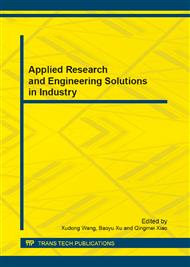p.3
p.11
p.16
p.21
p.25
p.29
p.33
p.37
Study on Effect of Spindle on Dynamic Performance and Surface Quality of Whole Machine Tool
Abstract:
This paper describes a comparison case study devised to quantify the effect of spindle on dynamic performance and surface quality of a vertical machine center. Measurements are performed to evaluate the: (1) spindle thermal growth using infrared temperature measurement instrument; (2) idling vibration of the spindle at different speeds using the laser interferometer; (3) transfer dynamic stiffness of the spindle using LMS; (4) machining surface quality using surface roughometer. The integrated effect of the spindle assembly process on the above performances has been identified. A detailed comparative analysis of the surface quality showed that the accuracy loss of the vibration induced by the machining force and the unbalance of the spindle system is dominant for the machine tool selected for this study.
Info:
Periodical:
Pages:
11-15
Citation:
Online since:
February 2013
Authors:
Price:
Сopyright:
© 2013 Trans Tech Publications Ltd. All Rights Reserved
Share:
Citation:


